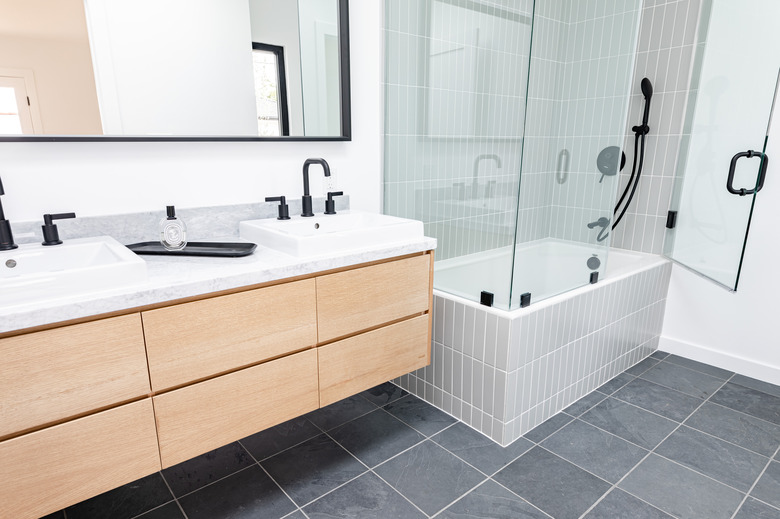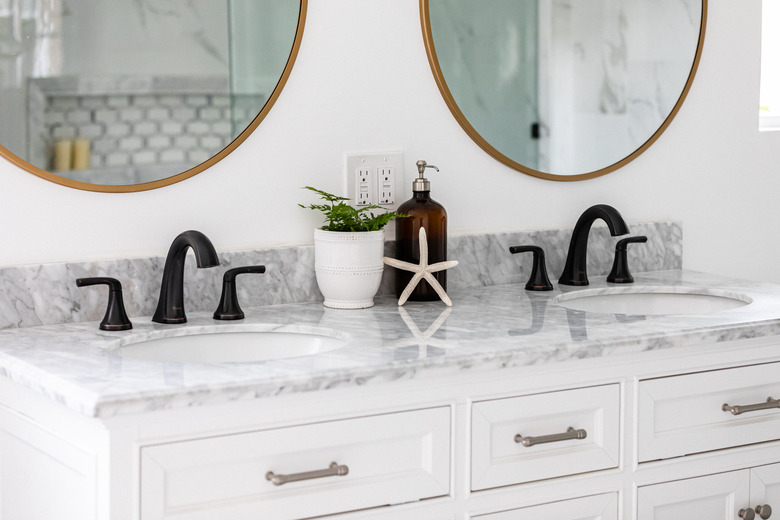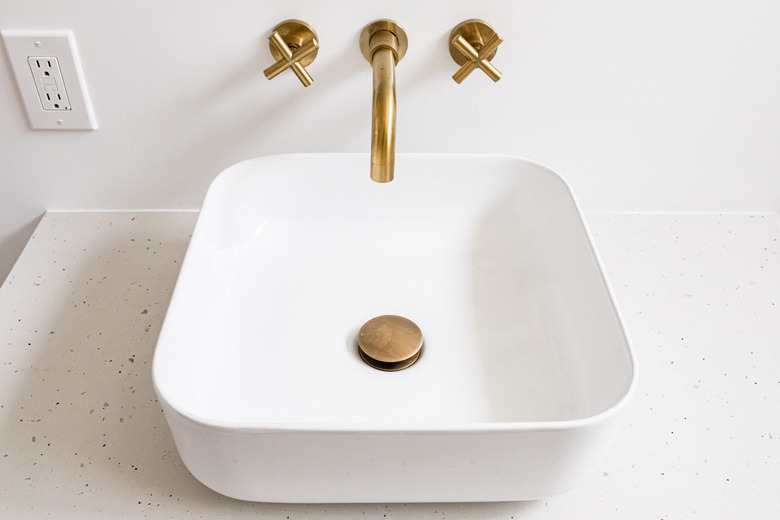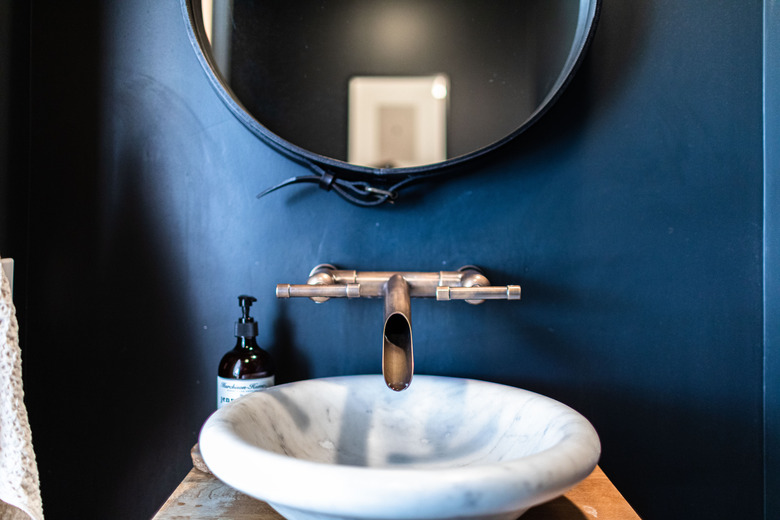Complete Guide To Bathroom Sink Faucets
One bathroom sink faucet is not equal to the next, so choosing one is a bit more complicated than simply grabbing any faucet off the shelf at your local home improvement center. While the aerator on each bathroom faucet is relatively the same as the next, many of the other features vary greatly and may not even work well with your sink. The mounting position, number of mounting holes required and even the height of the faucet are all important factors to consider when looking for the ideal faucet to pair with your bathroom sink.
Deck-Mount Faucets
Deck-Mount Faucets
Before getting into styles, shapes and specific bathroom faucet details, the key factor to consider is whether the sink should have a deck-mount or wall-mount faucet. A deck-mount faucet is any kind that mounts on the horizontal surface behind the sink bowl, whether this is part of the sink or part of the countertop (vanity top) behind it. If you are looking at new sinks, check the sinks for holes drilled for faucet hardware along the back of the sink. These holes also indicate which types of faucets should be used with any particular sink model.
If the sink has no predrilled faucet holes, a deck-mounted faucet attaches through the vanity top instead of the actual sink. This means the countertop surface must have holes cut to fit the faucet hardware. Big-box home improvement centers offer vanities or just the vanity tops with one or three holes already in place for faucets as well as a larger hole to fit a drop-in sink.
Buying a top with the holes already in place is an easier alternative to drilling your own holes through thick, hard vanity tops such as natural stone, although you may be able to modify a vanity top made of plastic laminate, solid surface or wood. If you are adding your own holes to a vanity top, make sure there's enough room to fit the faucet hardware base assembly behind the sink.
Working with a vessel sink also requires adding a deck-mount bathroom sink faucet behind the actual sink through the countertop unless you plan on installing a wall-mount faucet. Even though many vessel sinks pair with deck-mount faucets, a vessel sink cannot use a standard deck-mount faucet because of the vessel's height. In this case, a taller faucet specifically designed for a vessel sink is the best option. Look for one that's several inches taller than the top of the vessel sink rim.
Also, when the faucet is mounted, its spout should pour directly onto the sink drain rather than toward the front or back of the sink basin. If water primarily hits along the sides of the bowl rather than the basin's lowest point, it could splash out of the bowl.
Wall-Mount Faucets
Wall-Mount Faucets
A wall-mounted faucet protrudes from the wall, which means a bit more freedom as far as faucet placement but also a lot of work during installation. In most cases, unless your bathroom already has a wall-mount faucet, a professional should do the plumbing installation because the existing water pipes must be extended higher than the sink level within the wall.
This usually requires cutting holes in the wall to access the plumbing as well as adding blocking to the studs to support the faucet hardware. Once the plumbing job is complete, you'll also have to repair and repaint or otherwise redecorate the affected wall area.
While you have a lot of freedom as far as the positioning of a wall-mounted faucet, this could also be a drawback. It's hard to tell ahead of time just how high is too high to prevent splashing when water pours out of the spout. If the spout is too low, it may be difficult to wash your hands or your hair if you wash your hair in the sink. In most cases, the faucet manufacturer offers recommendations for the ideal faucet height.
A wall-mounted faucet is a little easier to keep clean than the deck-mount variety, as there's no chance of water pooling at its base. It also doesn't take up valuable countertop or sink space. If you ever remodel the sink area again, it's easy to replace the vanity or the sink itself without having to remove a wall-mounted faucet or disconnect its plumbing.
Count the Faucet Holes
Count the Faucet Holes
The placement and number of faucet holes in the sink or the vanity top are key factors that help determine which kind of faucet is best for your sink. For instance, three faucet holes means the sink (or counter surface) is designed for a faucet with two handles, while one hole indicates a single-handled or double-handled faucet that fits a single hole.
When shopping for faucets, look for specific faucet terminology, such as single hole, centerset or widespread. A single-hole bathroom sink faucet, as the name implies, is for a surface with only one faucet hole. The most common single-hole bathroom faucets have a single handle mounted on the faucet assembly to control water flow and temperature.
A centerset faucet has the spout, handles and stopper assembly attached to a decorative base plate so the entire unit fits into place on the sink or countertop. These are among the most common bathroom sink faucets. A centerset faucet is designed for a sink or countertop with three faucet holes, with the outer holes 4 inches apart from one another center to center. In some cases, the holes are 6 inches apart, so it's important to measure the faucet hole spacing before purchasing a centerset faucet. Centerset faucets always have two handles that are equally spaced on either side of the spout assembly.
A widespread faucet kit also fits a sink or countertop with three holes. In this case, the handles and the faucet spout are all separate pieces, so the spacing of the handles does not have to conform to the 4- or 6-inch layout used by centerset faucets. These can be used on sinks or vanity tops with faucet handle holes set 8 inches apart or even farther. Widespread faucets can also be mounted in nonstandard configurations if necessary, based on available countertop space.
Choosing a Valve Type
Choosing a Valve Type
Most new bathroom sink faucets have one or two replaceable cartridges inside to control water flow and temperature. While the cartridges last a while, some eventually fail, resulting in the need to replace components within them or replace the entire cartridge. In many cases, accessing and replacing the cartridge is a simple process that does not require a plumber.
A standard cartridge, such as those used in Moen single-handle faucets, uses a cylinder inside of the cartridge housing to control both the water flow and the water temperature. Though the Moen brand came up with the original concept, this type of cartridge is the standard for all single-handle, nonceramic, cartridge-based faucets no matter the brand.
The quality of the cartridge depends on its composition, typically made of either plastic or brass, with brass lasting longer. This type of cartridge usually lasts at least five years. If the faucet starts to drip, the problem is easy to solve by replacing O-rings and seals on the cartridge or by replacing the entire cartridge.
Ceramic cartridge valves tend to last longer than standard cartridges. The ceramic pieces that control water flow won't wear down from friction and can last anywhere from five years to the lifetime of the faucet. Even so, they're not completely fail-proof.
Hard debris that becomes trapped between the ceramic components could prevent the ceramic pieces from completely cutting off water flow, which means you'll try even harder to shut off the water. When this happens, the brittle ceramic pieces could shatter, and you'll have to replace the cartridge, according to Kingston Brass. Ceramic cartridges are typically found on high-quality faucets.
Bathroom Faucet Handles
Bathroom Faucet Handles
While bathroom faucets come in a vast array of styles and finishes, the same holds true for the faucet handles. Beyond aesthetics, the style of handle impacts how easy it is to turn the water on and off or to mix hot and cold water to achieve the desired water temperature. A model with a single handle is easier to manipulate and to install than a two-handled faucet. The single handle also has one less item to clean compared to a two-handled version.
When it comes to faucets with two handles, several options are available. Cross handles are vintage-style handles that operate much like an outdoor faucet. The ceramic or metal cross or X-shaped pieces sit horizontally atop the handle housing. These are easy to grip even with wet or greasy hands or for those who have difficulty grasping and turning smooth objects. Some two-handled sinks have levers that turn horizontally to control water pressure and temperature. No matter the design, it is a bit easier to control the mix of hot and cold water when using two separate handles compared to one handle or knob to control the mix and the water pressure.
Touch-free or touchless bathroom faucets are also an option that comes in handy when washing hands covered in grime or paint. These require an electricity hookup or a battery. Plug-in models are designed to plug in from underneath the countertop or sink, so an outlet is necessary behind the vanity or under the sink.
Faucet Composition Materials
Faucet Composition Materials
While the average faucet could last a lifetime with proper care, some are built with more durable materials than others. The finish isn't a true indicator of the faucet's composition, as faucets can be plated with other materials. Brass has been used to make faucets for many years, largely due to its natural resistance to corrosion. Solid brass faucets feel heavier than many other faucets and also cost a bit more, running $150 and up.
Zinc alloy faucets are die cast and cost about half the price of solid brass faucets, but these tend to corrode once the metal plating wears off. Even so, a quality metal plating job, such as chrome electroplating, could make the faucet last for decades. In some cases, the faucet packaging may list "zamac" or "zamak" as the material; these are just other terms for "zinc alloy."
Faucets made of plastic and coated with a metallic finish are the least expensive, but they also break down quicker. These are best avoided, as they simply don't last.
References
- Ferguson Enterprises: Bathroom Sink Faucets Buying Guide
- Lowe's: Bathroom Faucet Buying Guide
- StarCraft Custom Builders: Faucet Valves & Cartridges
- Kingston Brass: The Ubiquitous Question: What is the Difference Between Ceramic and Washerless Cartridges?
- Wise Builders: Pros and Cons of Bath Wall-Mounted Faucets
- AJ Madison: Sink and Faucets Buying Guide
- American Standard: What Are the Different Mounting Options for Bathroom Faucets?



